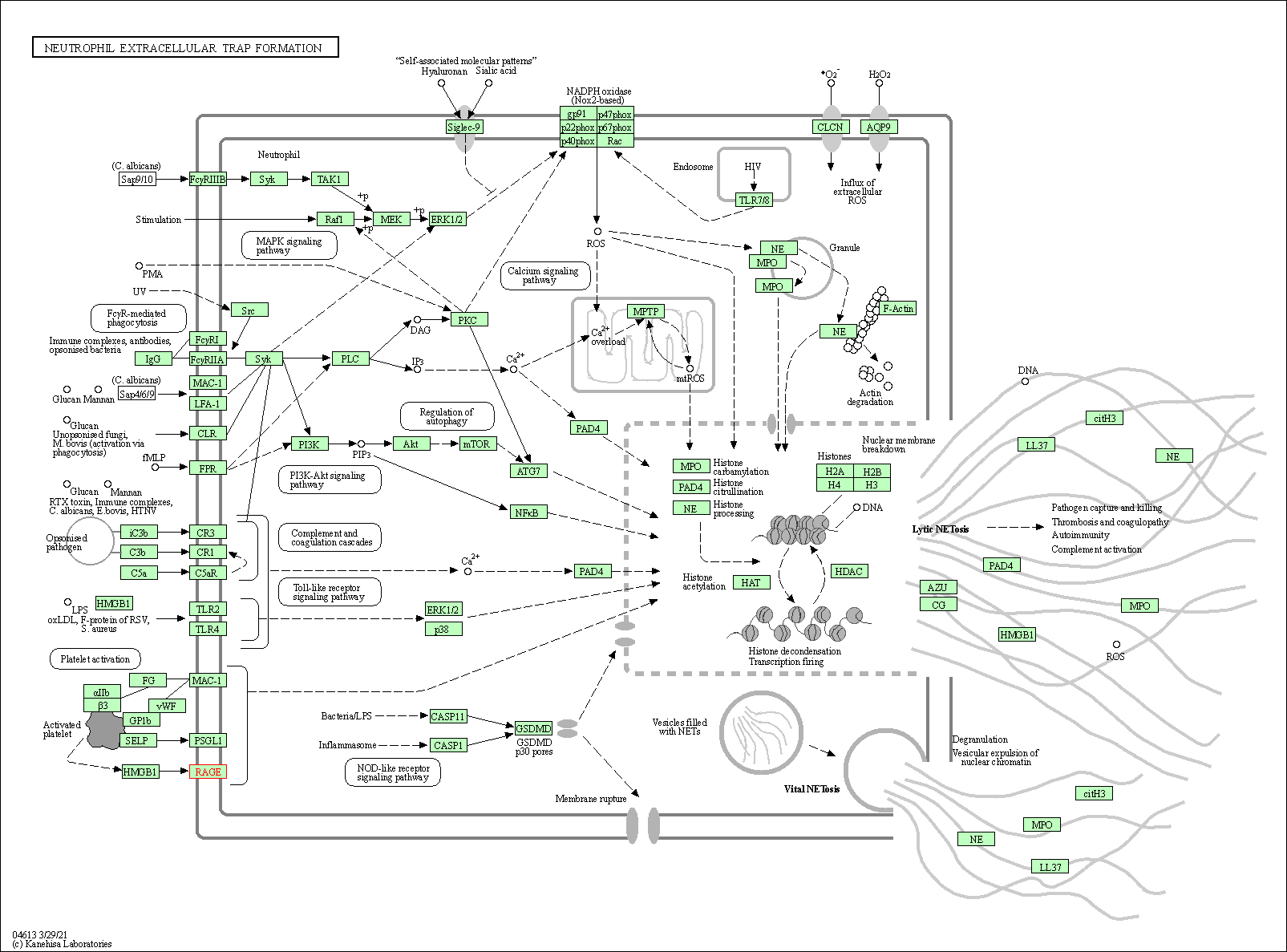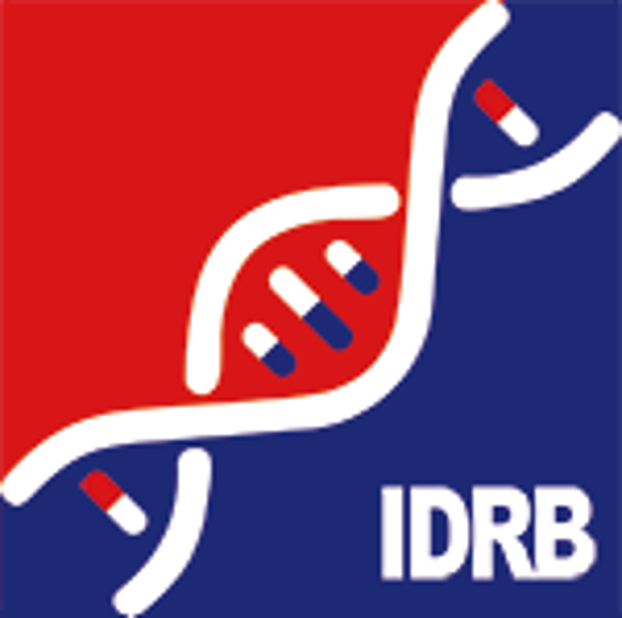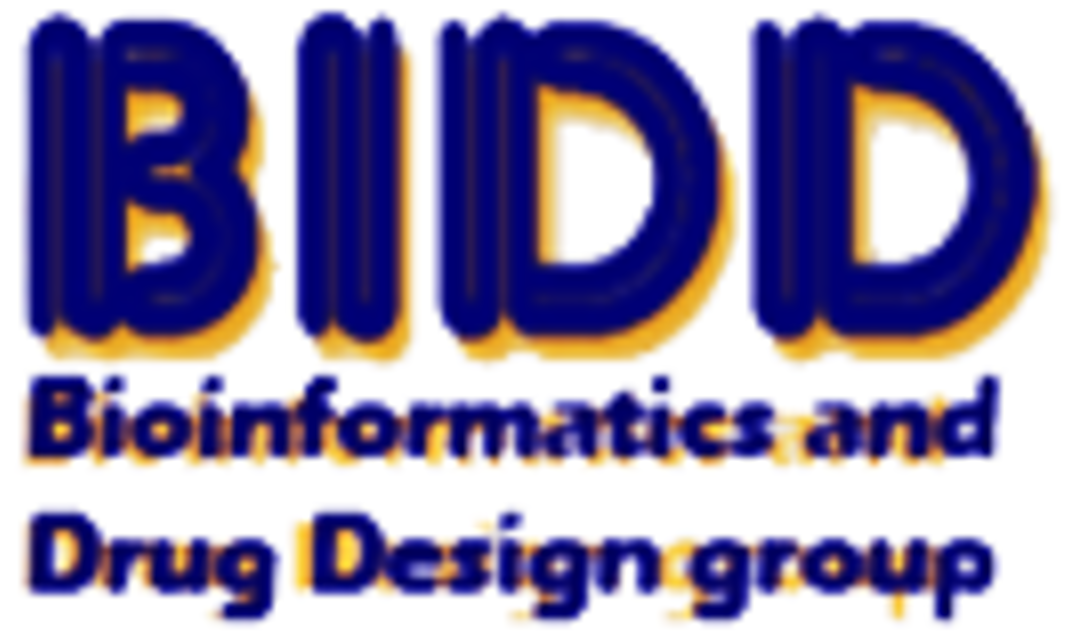Target Information
| Target General Information | Top | |||||
|---|---|---|---|---|---|---|
| Target ID |
T07400
(Former ID: TTDR00745)
|
|||||
| Target Name |
Advanced glycosylation end product receptor (AGER)
|
|||||
| Synonyms |
Receptor foradvanced glycosylation end products; RAGESEC; RAGE; AGER
Click to Show/Hide
|
|||||
| Gene Name |
AGER
|
|||||
| Target Type |
Clinical trial target
|
[1] | ||||
| Disease | [+] 4 Target-related Diseases | + | ||||
| 1 | Alzheimer disease [ICD-11: 8A20] | |||||
| 2 | Chronic kidney disease [ICD-11: GB61] | |||||
| 3 | Dementia [ICD-11: 6D80-6D8Z] | |||||
| 4 | Hypotension [ICD-11: BA20-BA21] | |||||
| Function |
Mediates interactions of advanced glycosylation end products (age). These are nonenzymatically glycosylated proteins which accumulate in vascular tissue in aging and at an accelerated rate in diabetes. Receptor for amyloid beta peptide.
Click to Show/Hide
|
|||||
| BioChemical Class |
Immunoglobulin
|
|||||
| UniProt ID | ||||||
| Sequence |
MAAGTAVGAWVLVLSLWGAVVGAQNITARIGEPLVLKCKGAPKKPPQRLEWKLNTGRTEA
WKVLSPQGGGPWDSVARVLPNGSLFLPAVGIQDEGIFRCQAMNRNGKETKSNYRVRVYQI PGKPEIVDSASELTAGVPNKVGTCVSEGSYPAGTLSWHLDGKPLVPNEKGVSVKEQTRRH PETGLFTLQSELMVTPARGGDPRPTFSCSFSPGLPRHRALRTAPIQPRVWEPVPLEEVQL VVEPEGGAVAPGGTVTLTCEVPAQPSPQIHWMKDGVPLPLPPSPVLILPEIGPQDQGTYS CVATHSSHGPQESRAVSISIIEPGEEGPTAGSVGGSGLGTLALALGILGGLGTAALLIGV ILWQRRQRRGEERKAPENQEEEEERAELNQSEEPEAGESSTGGP Click to Show/Hide
|
|||||
| 3D Structure | Click to Show 3D Structure of This Target | AlphaFold | ||||
| HIT2.0 ID | T59Y35 | |||||
| Drugs and Modes of Action | Top | |||||
|---|---|---|---|---|---|---|
| Clinical Trial Drug(s) | [+] 5 Clinical Trial Drugs | + | ||||
| 1 | PF-4494700 | Drug Info | Phase 3 | Dementia | [2], [3] | |
| 2 | Pyridoxamine | Drug Info | Phase 3 | Diabetic nephropathy | [4] | |
| 3 | Alagebrium chloride | Drug Info | Phase 2/3 | Hypotension | [5] | |
| 4 | TTP-448 | Drug Info | Phase 2 | Alzheimer disease | [6] | |
| 5 | TTP-4000 | Drug Info | Phase 1 | Alzheimer disease | [7] | |
| Mode of Action | [+] 4 Modes of Action | + | ||||
| Antagonist | [+] 1 Antagonist drugs | + | ||||
| 1 | PF-4494700 | Drug Info | [1] | |||
| Inhibitor | [+] 2 Inhibitor drugs | + | ||||
| 1 | Pyridoxamine | Drug Info | [8], [9] | |||
| 2 | TTP-4000 | Drug Info | [12] | |||
| Breaker | [+] 1 Breaker drugs | + | ||||
| 1 | Alagebrium chloride | Drug Info | [10], [11] | |||
| Modulator | [+] 2 Modulator drugs | + | ||||
| 1 | TTP-448 | Drug Info | [1] | |||
| 2 | DBT-066 | Drug Info | [13] | |||
| Cell-based Target Expression Variations | Top | |||||
|---|---|---|---|---|---|---|
| Cell-based Target Expression Variations | ||||||
| Drug Binding Sites of Target | Top | |||||
|---|---|---|---|---|---|---|
| Ligand Name: 3-[3-({[3-(4-carboxyphenoxy)phenyl]methoxy}methyl)phenyl]-1H-indole-2-carboxylic acid | Ligand Info | |||||
| Structure Description | Receptor for Advanced Glycation End Products VC1 domain in complex with 3-(3-((4-(4-carboxyphenoxy)benzyl)oxy)phenyl)-1H-indole-2-carboxylic acid | PDB:6XQ1 | ||||
| Method | X-ray diffraction | Resolution | 1.51 Å | Mutation | No | [14] |
| PDB Sequence |
GAMAQNITAR
29 IGEPLVLKCK39 GAPKKPPQRL49 EWKLNTGRTE59 AWKVLSPQGG69 GPWDSVARVL 79 PNGSLFLPAV89 GIQDEGIFRC99 QAMNRNGKET109 KSNYRVRVYQ119 IPGKPEIVDS 129 ASELTAGVPN139 KVGTCVSEGS149 YPAGTLSWHL159 DGKPLVPNEK169 GVSVKEQTRR 179 HPETGLFTLQ189 SELMVTPARG199 GDPRPTFSCS209 FSPGLPRHRA219 LRTAPIQPRV 229 WE
|
|||||
|
|
||||||
| Ligand Name: 3-(3-{[3-(4-carboxyphenoxy)phenyl]methoxy}phenyl)-1H-indole-2-carboxylic acid | Ligand Info | |||||
| Structure Description | Receptor for Advanced Glycation End Products VC1 domain in complex with 3-(3-(((3-(4-Carboxyphenoxy)benzyl)oxy)methyl)phenyl)-1H-indole-2-carboxylic acid | PDB:6XQ3 | ||||
| Method | X-ray diffraction | Resolution | 1.71 Å | Mutation | No | [14] |
| PDB Sequence |
GAMAQNITAR
29 IGEPLVLKCK39 GAPKKPPQRL49 EWKLNTGRTE59 AWKVLSPQGG69 GPWDSVARVL 79 PNGSLFLPAV89 GIQDEGIFRC99 QAMNRNGKET109 KSNYRVRVYQ119 IPGKPEIVDS 129 ASELTAGVPN139 KVGTCVSEGS149 YPAGTLSWHL159 DGKPLVPNEK169 GVSVKEQTRR 179 HPETGLFTLQ189 SELMVTPARG199 GDPRPTFSCS209 FSPGLPRHRA219 LRTAPIQPRV 229 WE
|
|||||
|
|
ALA21
3.466
MET22
2.781
ALA23
3.907
GLN24
4.276
LYS39
3.023
PRO45
2.687
GLN47
4.450
GLU50
3.197
TRP51
4.253
LYS52
3.317
PRO66
3.169
GLN67
3.220
ASP73
2.701
SER74
3.077
|
|||||
| Click to View More Binding Site Information of This Target with Different Ligands | ||||||
| Different Human System Profiles of Target | Top |
|---|---|
|
Human Similarity Proteins
of target is determined by comparing the sequence similarity of all human proteins with the target based on BLAST. The similarity proteins for a target are defined as the proteins with E-value < 0.005 and outside the protein families of the target.
A target that has fewer human similarity proteins outside its family is commonly regarded to possess a greater capacity to avoid undesired interactions and thus increase the possibility of finding successful drugs
(Brief Bioinform, 21: 649-662, 2020).
Human Tissue Distribution
of target is determined from a proteomics study that quantified more than 12,000 genes across 32 normal human tissues. Tissue Specificity (TS) score was used to define the enrichment of target across tissues.
The distribution of targets among different tissues or organs need to be taken into consideration when assessing the target druggability, as it is generally accepted that the wider the target distribution, the greater the concern over potential adverse effects
(Nat Rev Drug Discov, 20: 64-81, 2021).
Human Pathway Affiliation
of target is determined by the life-essential pathways provided on KEGG database. The target-affiliated pathways were defined based on the following two criteria (a) the pathways of the studied target should be life-essential for both healthy individuals and patients, and (b) the studied target should occupy an upstream position in the pathways and therefore had the ability to regulate biological function.
Targets involved in a fewer pathways have greater likelihood to be successfully developed, while those associated with more human pathways increase the chance of undesirable interferences with other human processes
(Pharmacol Rev, 58: 259-279, 2006).
Biological Network Descriptors
of target is determined based on a human protein-protein interactions (PPI) network consisting of 9,309 proteins and 52,713 PPIs, which were with a high confidence score of ≥ 0.95 collected from STRING database.
The network properties of targets based on protein-protein interactions (PPIs) have been widely adopted for the assessment of target’s druggability. Proteins with high node degree tend to have a high impact on network function through multiple interactions, while proteins with high betweenness centrality are regarded to be central for communication in interaction networks and regulate the flow of signaling information
(Front Pharmacol, 9, 1245, 2018;
Curr Opin Struct Biol. 44:134-142, 2017).
Human Similarity Proteins
Human Tissue Distribution
Human Pathway Affiliation
Biological Network Descriptors
|
|
|
Note:
If a protein has TS (tissue specficity) scores at least in one tissue >= 2.5, this protein is called tissue-enriched (including tissue-enriched-but-not-specific and tissue-specific). In the plots, the vertical lines are at thresholds 2.5 and 4.
|
| KEGG Pathway | Pathway ID | Affiliated Target | Pathway Map |
|---|---|---|---|
| Neutrophil extracellular trap formation | hsa04613 | Affiliated Target |

|
| Class: Organismal Systems => Immune system | Pathway Hierarchy | ||
| Degree | 7 | Degree centrality | 7.52E-04 | Betweenness centrality | 5.24E-04 |
|---|---|---|---|---|---|
| Closeness centrality | 2.11E-01 | Radiality | 1.37E+01 | Clustering coefficient | 4.76E-02 |
| Neighborhood connectivity | 1.33E+01 | Topological coefficient | 1.65E-01 | Eccentricity | 12 |
| Download | Click to Download the Full PPI Network of This Target | ||||
| Chemical Structure based Activity Landscape of Target | Top |
|---|---|
| Drug Property Profile of Target | Top | |
|---|---|---|
| (1) Molecular Weight (mw) based Drug Clustering | (2) Octanol/Water Partition Coefficient (xlogp) based Drug Clustering | |
|
|
||
| (3) Hydrogen Bond Donor Count (hbonddonor) based Drug Clustering | (4) Hydrogen Bond Acceptor Count (hbondacc) based Drug Clustering | |
|
|
||
| (5) Rotatable Bond Count (rotbonds) based Drug Clustering | (6) Topological Polar Surface Area (polararea) based Drug Clustering | |
|
|
||
| "RO5" indicates the cutoff set by lipinski's rule of five; "D123AB" colored in GREEN denotes the no violation of any cutoff in lipinski's rule of five; "D123AB" colored in PURPLE refers to the violation of only one cutoff in lipinski's rule of five; "D123AB" colored in BLACK represents the violation of more than one cutoffs in lipinski's rule of five | ||
| Target Profiles in Patients | Top | |||||
|---|---|---|---|---|---|---|
| Target Expression Profile (TEP) | ||||||
| Target Affiliated Biological Pathways | Top | |||||
|---|---|---|---|---|---|---|
| PID Pathway | [+] 1 PID Pathways | + | ||||
| 1 | amb2 Integrin signaling | |||||
| Reactome | [+] 5 Reactome Pathways | + | ||||
| 1 | RIP-mediated NFkB activation via ZBP1 | |||||
| 2 | DEx/H-box helicases activate type I IFN and inflammatory cytokines production | |||||
| 3 | TAK1 activates NFkB by phosphorylation and activation of IKKs complex | |||||
| 4 | Advanced glycosylation endproduct receptor signaling | |||||
| 5 | TRAF6 mediated NF-kB activation | |||||
| WikiPathways | [+] 7 WikiPathways | + | ||||
| 1 | NRF2 pathway | |||||
| 2 | Nuclear Receptors Meta-Pathway | |||||
| 3 | Cytosolic sensors of pathogen-associated DNA | |||||
| 4 | TAK1 activates NFkB by phosphorylation and activation of IKKs complex | |||||
| 5 | AGE/RAGE pathway | |||||
| 6 | RIG-I/MDA5 mediated induction of IFN-alpha/beta pathways | |||||
| 7 | Advanced glycosylation endproduct receptor signaling | |||||
| References | Top | |||||
|---|---|---|---|---|---|---|
| REF 1 | Receptor for advanced glycation endproduct modulators: a new therapeutic target in Alzheimer's disease. Expert Opin Investig Drugs. 2015 Mar;24(3):393-9. | |||||
| REF 2 | URL: http://www.guidetopharmacology.org Nucleic Acids Res. 2015 Oct 12. pii: gkv1037. The IUPHAR/BPS Guide to PHARMACOLOGY in 2016: towards curated quantitative interactions between 1300 protein targets and 6000 ligands. (Ligand id: 8317). | |||||
| REF 3 | ClinicalTrials.gov (NCT02080364) Evaluation of the Efficacy and Safety of Azeliragon (TTP488) in Patients With Mild Alzheimer's Disease. U.S. National Institutes of Health. | |||||
| REF 4 | ClinicalTrials.gov (NCT02156843) Pyridorin in Diabetic Nephropathy. U.S. National Institutes of Health. | |||||
| REF 5 | ClinicalTrials.gov (NCT01417663) Effects of Exercise Training and AGE-crosslink Breaker on Cardiovascular Structure and Function. U.S. National Institutes of Health. | |||||
| REF 6 | Biopharmaceutical Research Companies are Developing Nearly 100 Medicines for Alzheimer's Disease and Other Dementias. Pharmaceutical Research and Manufacturers of America report. 2012. | |||||
| REF 7 | ClinicalTrials.gov (NCT01548430) A Safety Study of TTP4000 in Subjects With Alzheimer's Disease. U.S. National Institutes of Health. | |||||
| REF 8 | Pyridoxamine, an inhibitor of advanced glycation end product (AGE) formation ameliorates insulin resistance in obese, type 2 diabetic mice. Protein Pept Lett. 2010 Sep;17(9):1177-81. | |||||
| REF 9 | The AGE inhibitor pyridoxamine inhibits development of retinopathy in experimental diabetes. Diabetes. 2002 Sep;51(9):2826-32. | |||||
| REF 10 | Effect of the age cross-link breaker alagebrium on anterior segment physiology, morphology, and ocular age and rage. Trans Am Ophthalmol Soc. 2009 Dec;107:146-58. | |||||
| REF 11 | Alagebrium reduces glomerular fibrogenesis and inflammation beyond preventing RAGE activation in diabetic apolipoprotein E knockout mice. Diabetes. 2012 Aug;61(8):2105-13. | |||||
| REF 12 | Receptor for advanced glycation end products: its role in Alzheimer's disease and other neurological diseases. Future Neurol. 2009; 4(2): 167-177. | |||||
| REF 13 | URL: http://www.guidetopharmacology.org Nucleic Acids Res. 2015 Oct 12. pii: gkv1037. The IUPHAR/BPS Guide to PHARMACOLOGY in 2016: towards curated quantitative interactions between 1300 protein targets and 6000 ligands. (Target id: 2843). | |||||
| REF 14 | A fragment-based approach to discovery of Receptor for Advanced Glycation End products inhibitors. Proteins. 2021 Nov;89(11):1399-1412. | |||||
If You Find Any Error in Data or Bug in Web Service, Please Kindly Report It to Dr. Zhou and Dr. Zhang.

